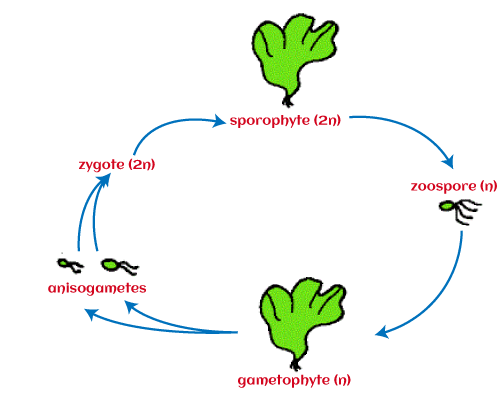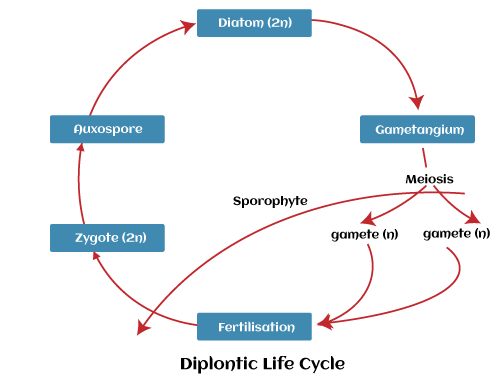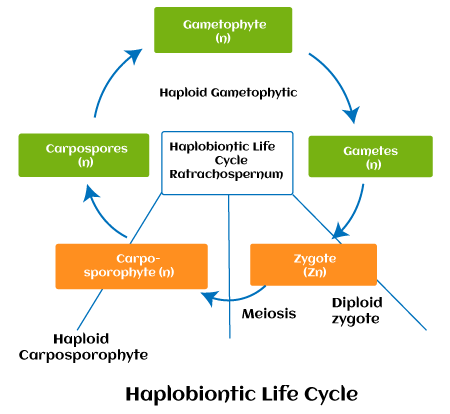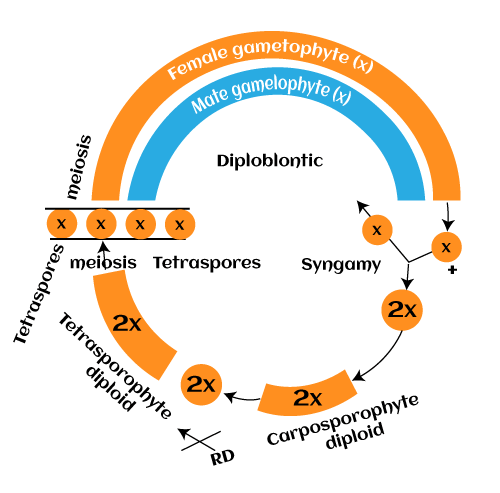Life Cycle of AlgaeThe life cycle of algae varies depending on the species, and there are four basic life cycle patterns in algae. There is an alternation of generations in all four patterns, indicating different haploid and diploid stages. In all life cycles, the haploid stage indicates gametophyte, while the diploid stage indicates sporophyte. 
Haploid refers to a cell or organism that contains a single set of chromosomes. Moreover, the organisms that reproduce asexually are called haploids. On the other hand, the organisms that reproduce sexually are called diploids, having two sets of chromosomes. Similarly, one such example can be seen in humans where only eggs and sperm cells are haploid cells, which produce diploid cell (zygote) after fertilization. Types of Life Cycle in AlgaeFour major types of life cycles in Algae are described below: 1. Haplontic Life Cycle:In the Haplontic life cycle, the plant body is called gametophyte (haploid). In contrast, the sporophyte (diploid) stage is exclusively represented by the zygote. In the gametangium, the gametophytic plant produces haploid gametes. The fusion of gametes culminates in the development of the zygote, which is the sole diploid stage of this life cycle, i.e. the sporophytic phase. The zygote divides into four meiospores during meiosis. These meiospores become haploid plants as they mature. The number of chromosomes can be used to interpret the alternation of generations. The monogenic life cycle is another name for this life cycle. The majority of Chlorophyceae, such as Chlamydomonas, Ulothrix, Oedogonium, Spirogyra, Chara, and others, as well as all members of the Xanthophyceae, have this type (haplontic) of life cycle. 2. Diplontic Life Cycle:Diplontic is multicellular sporophyte stage. In this type of life cycle, the sporophyte develops sex organs. Mitosis is the process by which sex organs create gametes. The gamete represents only the gametophytic stage; the gametes are quickly fertilised and form a zygote. The zygote does not go through meiosis and produces sporophytic plant bodies. 
The majority of Bacillariophyceae members and some Chlorophyceae members like Cladophora glomerata show this type of life cycle. Furthermore, the diplontic life cycle can also be found in Phaeophyceae plants such as Fucus and Sargassum. 3. Diplohaplontic Life Cycle:The haploid and diploid phases are equally dominant in this life cycle, which two vegetative individuals represent. Only the number and function of their chromosomes differ. 
The haploid gametophytic plant reproduces sexually, whereas the diploid sporophytic plant reproduces asexually. The two different vegetative individuals alternate with each other or sporogenic meiosis alternates with gametes fusion in this life cycle. Types of Diplohaplontic Life cycle are as follows:
4. Triphasic life cycleAlgae have a triphasic life cycle, as it has three distinct generations as described below: Algae have two different types of Triphasic life cycles:
Both these triphasic life cycles are unique. In simple words, the haplobiontic life cycle consists of two haploid generations and one diploid generation as shown in the below image: 
On other hand, the diplobiontic life cycle consists of two diploid generations and one haploid generation as shown below: 
The haploid gametophyte phase is dominant in the haplobiontic life cycle. In contrast, diploid sporophytes are the dominant stage in the diplobiontic triphasic life cycle. An example of this life cycle is found in the red algae of the genus Polysiphonia. Thus, from the above discussion, it is clear that there are several alternations of generations in algae and they do not have any fixed life cycle patterns as found in higher plants
Next TopicChara Algae
|
 For Videos Join Our Youtube Channel: Join Now
For Videos Join Our Youtube Channel: Join Now
Feedback
- Send your Feedback to [email protected]
Help Others, Please Share










